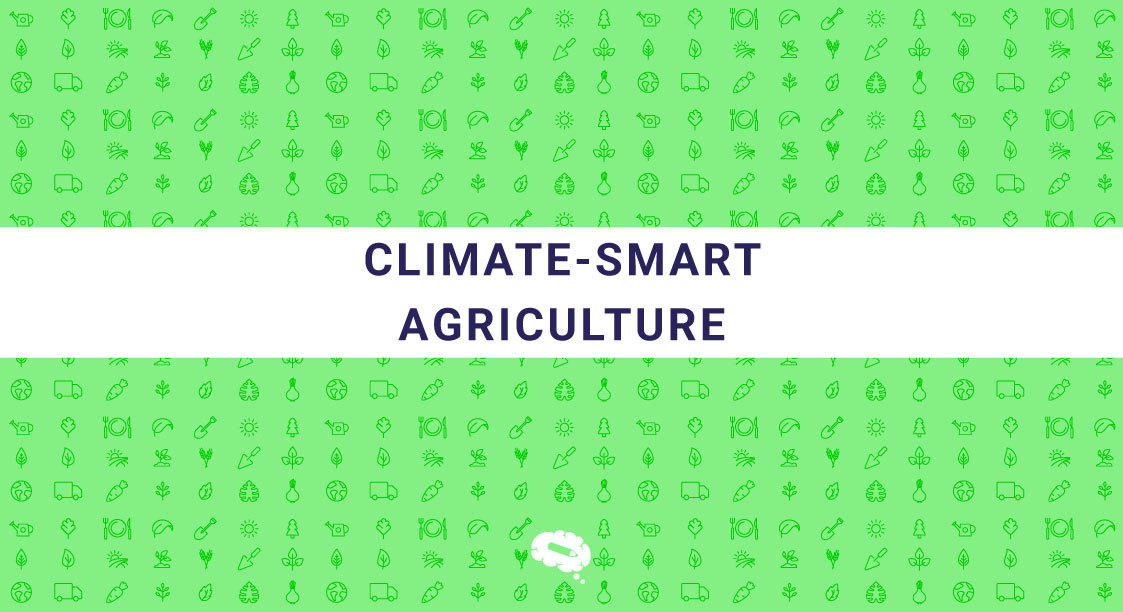In an era dominated by the pressing challenges of climate change, the agricultural landscape is experiencing dramatic instability in order to ensure resilience, sustainability, and production. This article explores the complexities of Climate-Smart Agriculture (CSA), a concept that integrates adaptation, mitigation, and resilience into agricultural practices.
As global temperatures increase and weather patterns vary, the need to create a sustainable and climate-resilient agriculture future has never been more urgent. This examination attempts to shed light on why adopting climate-smart agriculture is not simply an option, but an essential step in securing our food supply and cultivating a planet-friendly agricultural paradigm.
Climate Change And Agriculture
As the Earth’s climate continues to adapt in unexpected ways, agriculture finds itself at the forefront of a rapidly changing world. The delicate dance between climate change and agriculture is a dynamic and multifaceted interaction that reshapes not just existing agricultural practices but also has a significant impact on the future of food production.
Climate change, in its various behaviors, has a complex impact on agriculture, sending ripples through both the current and future prospects of this critical sector. The complex interplay emerges as a story of difficulties and adjustments, necessitating a closer look at how farming practices must evolve to meet the demands of an ever-changing climate.
Let’s look at the dynamic interaction between climate change and agriculture, studying the subtle ways in which these forces intersect and shape the agricultural landscape.
The Impact Of Climate Change On Agriculture
Current Impacts
- Temperature Extremes: Rising global temperatures cause more frequent and severe heat waves, reducing crop yields. Some crops are extremely sensitive to temperature variations throughout important growth stages, which reduces overall output.
- Altered Precipitation Patterns: Changes in precipitation, including shifts in rainfall patterns and increased frequency of extreme weather events like floods and droughts, disrupt planting and harvesting schedules. This instability can result in lower crop yields and greater susceptibility to pests and diseases.
- Water Scarcity: Changing climate patterns contribute to water scarcity, affecting irrigation and water availability for crops. Regions that rely largely on seasonal rainfall may have difficulty maintaining consistent agricultural practices.
- Rising Sea Levels: Coastal agriculture faces threats from rising sea levels, leading to saltwater intrusion into farmlands. This intrusion affects soil fertility and the appropriateness of land for cultivation.
- Increased Pest and Disease Pressure: Warmer temperatures and changed climatic conditions promote the spread of pests and illnesses. This poses a substantial threat to both crops and livestock forcing farmers to change their pest management practices.
Future Impacts
- Shifts in Growing Zones: As temperatures rise, conventional agricultural zones may shift, compromising the viability of particular crops in their existing places. Farmers will need to adjust by switching crop kinds or trying out innovative methods of cultivation.
- Reduced Crop Diversity: Climate change may reduce the variety of crops that may survive in some places. This decrease in diversity may enhance susceptibility to pests, diseases, and other environmental pressures.
- Extreme Weather Events: The frequency and severity of extreme weather events including hurricanes, floods, and droughts are predicted to rise. These occurrences can cause severe crop damage, disrupt supply lines, and result in food shortages.
- Livestock Challenges: Changes in temperature and water availability present issues for livestock farming. Heat stress can impair livestock productivity, and a lack of water and fodder can harm animal health.
- Global Food Security Concerns: The cumulative impact of these shifts raises questions about global food security. Disruptions in agricultural production, combined with population growth, could result in higher food costs and potential shortages.
The Role Of Agriculture In Climate Change
Agriculture, crucial for human existence, paradoxically contributes significantly to climate change. This relationship involves the emission of greenhouse gasses, deforestation, land-use change, and substantial energy consumption.
- Greenhouse Gas Emissions:
- Agriculture is a significant source of methane and nitrous oxide emissions.
- Livestock, especially in large-scale operations, release methane during digestion.
- Nitrogen-based fertilizers contribute to nitrous oxide emissions.
- Deforestation and Land Use Change:
- Agricultural expansion involves clearing forests, releasing stored carbon.
- Converting natural ecosystems into farmland alters landscapes and affects biodiversity.
- Energy Consumption:
- Modern agricultural practices heavily rely on machinery, irrigation, and transportation.
- Fossil fuel use in these processes contributes to a significant carbon footprint.
Climate-Smart Agricultural Practices
In response to the challenges posed by climate change, the agricultural sector is embracing innovative practices that not only adapt to the changing climate but also contribute to mitigation efforts. These climate-smart agriculture practices prioritize sustainability and resilience.
Defining Climate-Smart Agriculture
Climate-Smart Agriculture (CSA) is an integrated and adaptive farming approach that aims to address the problems of climate change while promoting sustainable and resilient agricultural practices. It entails the coordinated implementation of initiatives that increase production, reduce greenhouse gas emissions, and strengthen resistance to the effects of climate change.
- Adaptation: Enhancing the capacity of agriculture to adapt to the changing climate by implementing measures to cope with increased temperatures, altered precipitation patterns, and extreme weather events.
- Mitigation: Reducing the agricultural sector’s contribution to greenhouse gas emissions by implementing practices that optimize resource use, reduce emissions from livestock, and improve soil carbon sequestration.
- Resilience: Strengthening the ability of farming systems to withstand and recover from climatic shocks by incorporating diversified crops, improving water management, and adopting agroecological approaches to build resilience.
- Sustainable Intensification: Enhancing agricultural productivity while minimizing environmental impact by emphasizing efficient use of resources, optimizing input application, and promoting agroecological practices to achieve higher yields sustainably.
- Biodiversity Conservation: Promoting biodiversity within agricultural systems by implementing agroforestry, cover cropping, and crop diversification to enhance ecosystem services and support natural pest control.
- Economic Viability: Ensuring the economic sustainability of farming operations by integrating climate-smart practices that improve resource efficiency and reduce production costs, contributing to long-term economic viability.
- Community Engagement and Social Equity: Ensuring the active involvement and equitable distribution of benefits among farming communities by encouraging community participation in decision-making, knowledge sharing, and ensuring that vulnerable groups have access to climate-smart technologies and practices.
Examples Of Climate-Smart Agricultural Practices
The examples below showcase how each climate-smart agricultural practice contributes to enhanced resilience, sustainability, and adaptability in the face of a changing climate.
- Agroforestry: Integrating trees and shrubs into agricultural landscapes enhances biodiversity, improves soil health, and provides additional income sources for farmers. Trees offer shade, reduce water evaporation, and contribute to carbon sequestration.
- Conservation Agriculture: Implementing no-till or reduced-till farming helps retain soil moisture, reduces erosion, and preserves soil structure, promoting long-term sustainability and resilience.
- Crop Rotation and Diversification: Alternating crops in a planned sequence breaks pest and disease cycles, improves soil fertility, and enhances resilience. Diversification ensures a more robust farming system, reducing vulnerability to climate-induced stresses.
- Water-Smart Irrigation: Adopting efficient irrigation techniques like drip or precision irrigation minimizes water wastage, ensuring optimal water use in response to changing precipitation patterns. This practice promotes efficient resource utilization and resilience to water scarcity.
- Cover Cropping: Planting cover crops during non-growing seasons prevents soil erosion, improves soil structure, and enhances nutrient cycling. It contributes to overall farm resilience and reduces the need for synthetic fertilizers.
- Livestock Management: Implementing rotational grazing and optimizing feed efficiency reduces methane emissions and minimizes the environmental impact of animal farming. Practices such as rotational grazing promote healthier pastures and reduce overgrazing.
- Climate-Resilient Crop Varieties: Developing and adopting crop varieties resilient to climate stressors, including drought-resistant or heat-tolerant crops, ensures better yields under changing climate conditions. This promotes food security and adaptability in agricultural systems.
- Smart Fertilizer Use: Precision application of fertilizers minimizes environmental impact and reduces greenhouse gas emissions associated with nitrogen-based fertilizers. It optimizes nutrient application, enhancing both productivity and sustainability.
Implementing Climate-Smart Agriculture
Implementing climate-smart agriculture necessitates the adoption of strategic practices and principles aimed at bolstering agricultural resilience, mitigating the impacts of climate change, and ensuring long-term sustainability. Here are key strategies to effectively implement climate-smart agriculture.
By systematically incorporating these strategies, collaboration among farmers, policymakers, and communities can contribute to the creation of a resilient and sustainable agricultural system, well-equipped to thrive in the face of challenges posed by climate change.
Strategies For Successful Implementation
Comprehensive Assessment And Planning
- Conduct a thorough assessment of local climate risks, vulnerabilities, and conditions.
- Develop farm-level plans that consider the diverse range of crops, soil types, and unique local circumstances.
Adaptation Measures
- Diversify crop selections to include resilient varieties suited to local climate conditions.
- Implement efficient water management practices and conservation techniques in response to changing precipitation patterns.
- Embrace agroforestry to enhance biodiversity, improve soil health, and provide natural shade.
Mitigation Practices
- Adopt precision agriculture techniques leveraging technology for optimal resource management, reducing greenhouse gas emissions.
- Integrate renewable energy sources for farm operations to decrease dependence on fossil fuels.
- Implement practices to reduce methane emissions from livestock, such as improved feeding and rotational grazing.
Soil Health Management
- Integrate cover cropping to protect soil from erosion, enhance fertility, and sequester carbon.
- Embrace no-till farming and conservation agriculture practices to maintain soil structure and reduce erosion.
Technology Integration
- Leverage climate-smart technologies for weather monitoring, data analytics, and precision farming to make informed decisions.
- Explore biotechnological approaches for developing climate-resilient crop varieties.
Capacity Building
- Provide education and training programs to empower farmers with knowledge on climate-smart practices, emphasizing benefits and methodologies.
- Foster knowledge exchange platforms, encouraging farmers to share experiences, best practices, and innovative solutions.
Policy Support
- Offer financial incentives and subsidies to encourage the widespread adoption of climate-smart practices.
- Establish regulatory frameworks that support sustainable and climate-resilient agricultural approaches.
Community Engagement
- Encourage participatory approaches, involving local communities in decision-making processes.
- Promote social inclusion by ensuring equitable access to resources and benefits, particularly for vulnerable or marginalized groups.
Challenges And Barriers
Limited Financial Resources
- Farmers may lack the financial resources to invest in climate-smart technologies, implement sustainable practices, or adapt their infrastructure to changing climate conditions.
Lack Of Access To Information
- Limited access to climate information, weather forecasts, and knowledge about climate-smart practices hinders farmers’ ability to make informed decisions.
Technological Barriers
- The adoption of climate-smart technologies may be impeded by the lack of availability, affordability, or technical expertise required for implementation.
Inadequate Infrastructure
- Insufficient infrastructure, such as irrigation systems, roads, and storage facilities, can limit the adoption of climate-smart practices, hindering efficient and sustainable farming.
Resistance To Change
- Farmers may resist changing traditional practices, especially if they perceive new methods as risky or if there’s a lack of confidence in the effectiveness of climate-smart approaches.
Land Tenure And Property Rights
- Unclear land tenure and property rights can hinder long-term investments in sustainable practices, as farmers may be hesitant to adopt changes without secure land tenure.
Policy And Regulatory Challenges
- Inconsistent or inadequate policies and regulations related to climate-smart agriculture can impede widespread adoption. A lack of supportive frameworks may discourage farmers from making sustainable choices.
Market Access Issues
- Limited access to markets for climate-smart products, as well as a lack of incentives or certification programs, can deter farmers from investing in sustainable practices.
Climate Variability And Uncertainty
- Unpredictable climate patterns and extreme weather events can create uncertainty for farmers, making it challenging to plan and implement climate-smart practices effectively.
Limited Research And Development
- Insufficient investment in research and development for climate-smart agriculture may result in a lack of innovative solutions and effective strategies for diverse agricultural contexts.
Social And Cultural Factors
- Social and cultural norms may influence farming practices, and resistance to change based on traditional beliefs or practices can hinder the adoption of climate-smart techniques.
Lack Of Extension Services
- Inadequate extension services and outreach programs may limit farmers’ exposure to climate-smart practices and hinder the dissemination of knowledge.
Short-Term Economic Pressures
- Farmers facing immediate economic pressures may prioritize short-term gains over long-term investments in climate-smart agriculture, even if such practices are more sustainable.
Limited Collaboration And Coordination
- Ineffective collaboration and coordination among various stakeholders, including government bodies, NGOs, and local communities, may hinder the collective effort required for successful implementation.
Global Market Dynamics
- Global market dynamics and trade policies may not always favor climate-smart agricultural products, affecting the economic viability of sustainable practices.
Situational Examples Of Challenges
- In a region with erratic weather patterns, farmers faced difficulties implementing water-smart irrigation due to the lack of affordable technologies and access to updated weather information.
- Attempts to introduce climate-resilient crop varieties faced challenges in regions with unclear land tenure, as farmers were hesitant to invest in new seeds without secure property rights.
- A community faced resistance to adopting agroforestry practices due to cultural beliefs associated with open fields, highlighting the impact of social and cultural factors on climate-smart agriculture.
Conclusion
In tackling the severe challenges posed by climate change, agriculture is at a crossroads that requires innovation, resilience, and a relentless commitment to sustainability. The discussion of Climate-Smart Agriculture (CSA) in this article shows a dynamic approach that seamlessly incorporates adaptation, mitigation, and resilience into agricultural practices.
As global temperatures increase and weather patterns vary, the need to create a sustainable and climate-resilient agricultural future becomes evident.
Climate change and agriculture have a complex relationship, including temperature extremes, changing precipitation patterns, water scarcity, and increased pest pressure all having an impact on present practices. Looking ahead, expected shifts in growing zones, reducing crop diversity, severe weather events, and global food security issues create a difficult picture that demands proactive measures.
Recognizing agriculture’s paradoxical role in climate change, with considerable contributions to greenhouse gas emissions, deforestation, and energy use, emphasizes the importance of transformative actions. Climate-Smart Agriculture emerges as a comprehensive solution to solving agriculture’s multiple challenges.
However, this revolutionary journey is not without challenges. Limitations in financial resources, technological obstacles, unwillingness to change, and policy uncertainties must all be addressed.
The path forward requires collaborative action, innovation, and a steadfast commitment to establishing an environmentally responsible agriculture paradigm.
Your Creations, Ready Within Minutes!
Mind the Graph unlocks the power of visual communication, bringing your creations to life in minutes! Mind the Graph’s efficiency is evident in its pre-designed templates and straightforward drag-and-drop features, guaranteeing that your visuals are not only impactful but also created with unmatched ease. Improve your communication skills in business, academia, and education – Mind the Graph transforms your thoughts into visually stunning masterpieces!

Subscribe to our newsletter
Exclusive high quality content about effective visual
communication in science.








